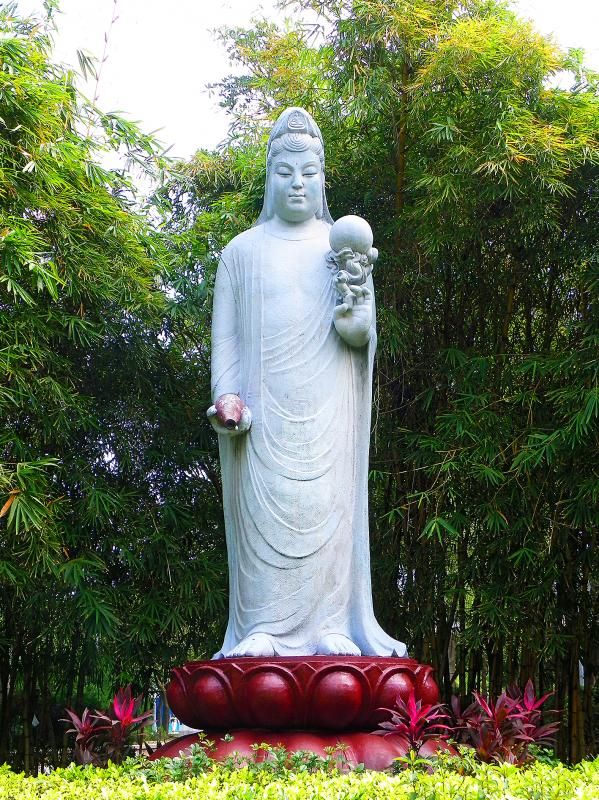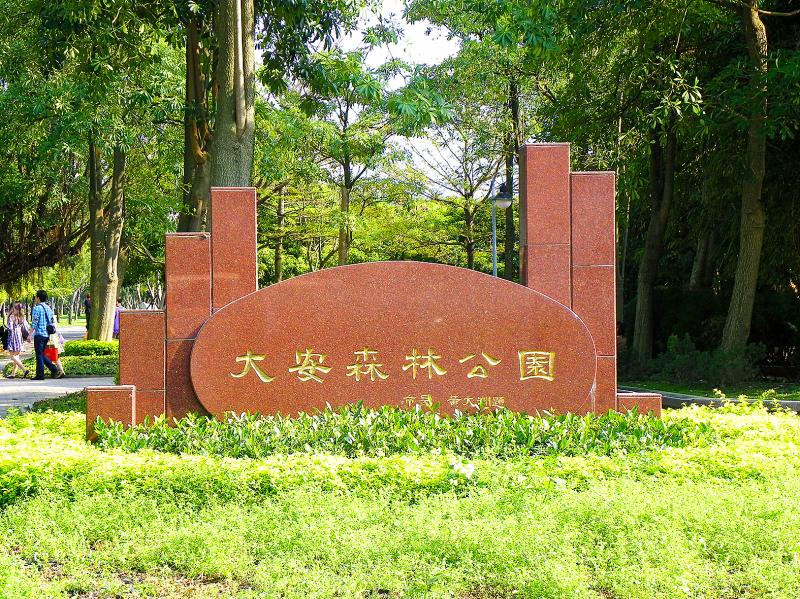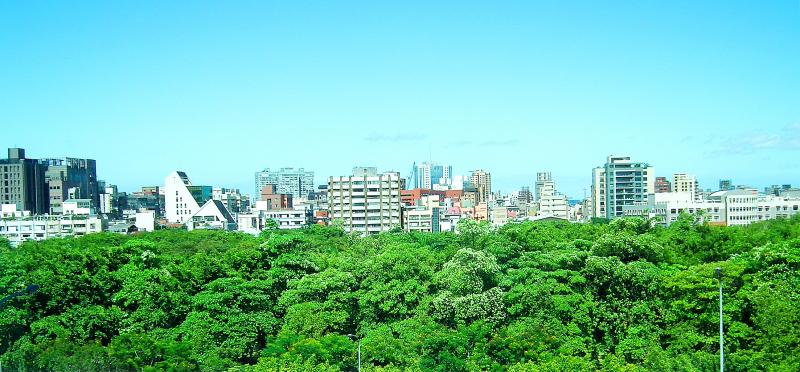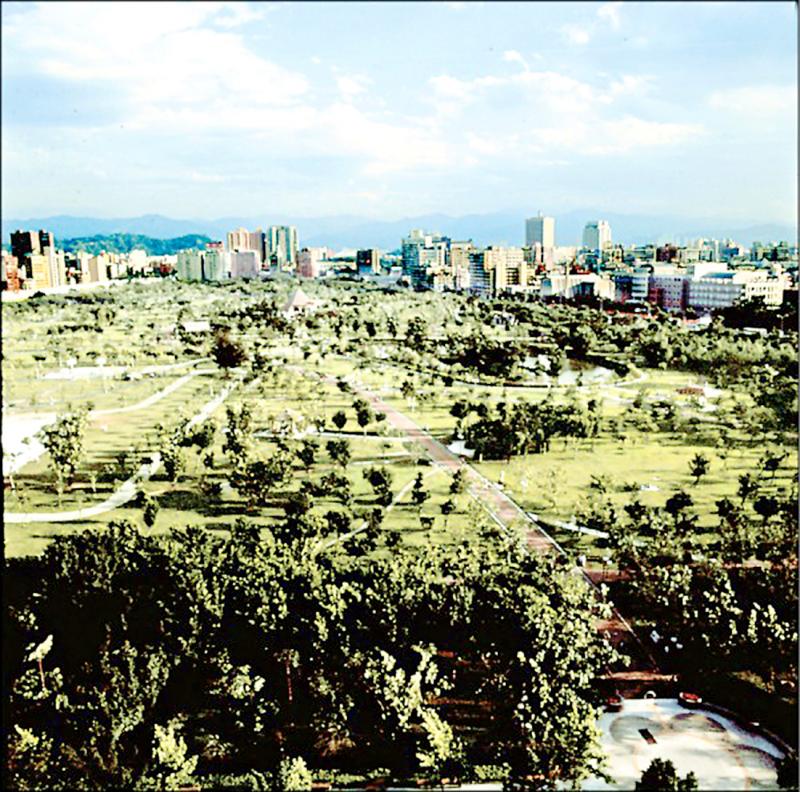March 28 to April 3
The Taipei City Government was in a panic. There were only six days left until the March 29, 1994 grand opening of Daan Forest Park and officials had yet to resolve an intense dispute — one that had gone on for two years — over whether to keep a large Guanyin statue on the park’s northwest corner.
Buddhist Master Shih Chao-hwei (釋昭慧) and independent legislator Lin Cheng-chieh (林正杰) were on day five of their hunger strike to save the statue, vowing to “defend the statue to the death” and rally their supporters to form a massive human barrier around it on opening day.

Photo courtesy of Wikimedia Commons
The government had hoped that the influential Fo Guang Shan Monastery could persuade the protestors to negotiate. But on the night of March 23, the monastery’s founder, Master Hsing Yun (星雲法師), announced his full support for the protest, saying that he would mobilize 325 tour buses full of people.
The city’s final offer was to keep the statue as public art, as long as believers refrained from using it for any religious activities. The protestors accepted and called off the hunger strike.
On the morning of March 27, 1994, Master Hsing Yun symbolically donated the Guanyin to then-mayor Huang Ta-chou (黃大洲) in a brief ceremony, finally drawing a close to the debacle.

Photo courtesy of Wikimedia Commons
Although the crisis was averted, the park’s grand opening was a disaster anyway. A Chinese Television Service (華視) video on YouTube shows hapless visitors trudging through ankle-deep mud and construction debris. And despite the celebratory events throughout the day, Taipei’s largest green space was painfully incomplete. The restrooms weren’t even functional yet.
There was still a ways to go before what was nicknamed “Mud Park” (泥巴公園) could live up to its promise as the “lungs of Taipei.”
LONG TERM PROJECT

Photo courtesy of Wikimedia Commons
Daan Forest Park was a project more than 60 years in the making. In 1932, the Japanese set aside 17 locations in Taipei to serve as future urban parkland. Each location was identified by number, and up until the 1990s, Daan Forest Park was called “Park No 7.”
The Chinese Nationalist Party (KMT) used most of these open areas for military purposes when they first arrived after World War II. Park No 7 housed two military dependent villages, various military facilities including a radio station, and the International House of Taipei. Illegal squatters, most of them refugees from the Chinese Civil War, also settled here, and up to a few thousand people may have lived there. The settlement continued to expand throughout the years as young people came to Taipei from the south to seek their fortunes.
The International House of Taipei’s gymnasium, located on the corner of Xinsheng South Road and Xinyi Road, was a hotspot for concerts, sports matches and movie screenings. It hosted several Miss China beauty pageants in the 1960s.

Photo courtesy of Chung Yung-ho
In 1984, the government briefly mulled building a 30,000-capacity stadium on the land instead of a park, but this was met with protests by environmentalists who advocated more green spaces in Taipei. The city decided on a “forest park” in 1989.
Life was not easy in these settlements, as shown in the 1983 movie Papa, Can You Hear Me Sing? (搭錯車), but people refused to leave when the government tried to relocate them. Their fierce resistance plays a significant part in the film, and a major character dies in a clash with the authorities. The city prevailed, and on April 2, 1992, they tore down the International House.
These residents generally supported the removal of the statue, as they found it unfair that it was allowed to remain while they lost everything. Many of them were Christian, and the demolition of the park reserve’s places of worship also drew the ire of non-Buddhist groups.
STATUE OF CONTROVERSY
Completed in 1985 by renowned sculptor Yuyu Yang (楊英風), the statue has been mired in controversy since its inception.
In 1979, Da Hsiung Monastery (大雄精舍) founder Chiu Hui-chun (邱慧君) reportedly received a message in a dream to build a new temple next to the International House of Taipei. Landowner Lin Tsung-hsien (林宗賢) was happy to allow it, but the government was reluctant to allow a structure when clearing the current land was already a problem.
The Buddhist community rallied and secured political support, reaching a deal where Chiu could build a statue for simple worship, but not a temple. The monastery promised not to interfere with Park No 7’s development and obey all government requests during planning and construction. This clearly wasn’t the case later.
The statue attracted many worshippers, who planted a bamboo forest around it as a natural house for it. Huang recalls that the monastery ignored the city’s repeated requests to move the statue, and they left the structure standing during the 1992 demolitions due to its sensitive nature.
This sparked the struggle that went on for years, and it didn’t help that the government kept changing its stance under pressure from whichever side had the upper hand. Removal advocates were dominant until June 1993, when someone splashed acid and feces on the statue. This sparked outrage in the Buddhist community. Within a week more than 10,000 signatures in support of the statue were gathered and brought to city hall by Da Hsiung Monastery abbott Master Ming Kuang (明光法師) and supporting politicians.
In September, Huang decided to retain the statue as public artwork, noting that along with the bamboo forest it would be a nice addition to the park. The statue would be fenced off with barriers, plants and flowers to prevent people from approaching.
Removal advocates were furious and launched an even stronger campaign. Within two months Huang ordered the monastery to remove the statue by the end of March 1994.
With a little over a month until the park’s grand opening, supporters launched the “Guanyin Don’t Go” campaign, which was joined by many Buddhist groups across the nation. More and more politicians also got on board, and the city was running out of time.
“Of course there was immense pressure,” Huang says years later in “A Study on Power and How it Shapes Spaces” (權力與空間形塑之研究) by Liao Shu-ting (廖淑婷). “Three hundred tour buses would paralyze Taipei’s traffic.”
Taiwan in Time, a column about Taiwan’s history that is published every Sunday, spotlights important or interesting events around the nation that either have anniversaries this week or are tied to current events.

The government released figures for October showing that, year on year, exports increased 49 percent to a record US$61.8 billion for the month. The dramatic increases were partly due to fall being the high season, but largely due to the AI boom driving demand for exports, which many investors fear is rapidly turning into a massive bubble. An editorial in this newspaper last month warned that the government should be ready in case the boom turns to bust. In previous boom-bust cycles, from shoes and textiles, through computer parts and accessories, to tools, bicycles and sporting goods, Taiwan has survived in

Nov. 30 to Dec. 6 It is said that those who refused to vacate Kipatauw’s upper settlement were knocked unconscious by Japanese agents and dragged to fingerprint the deeds. The Japanese coveted the site’s valuable white clay for Beitou District’s (北投) growing ceramics industry, and they were determined to acquire it by any means. The Indigenous Ketagalan settlement of Kipatauw had withstood centuries of external pressures and cultural erosion. Despite gradually losing much of their territory to Han settlers, they remained distinct into the early 20th century. By 1895, three communities persisted: the upper settlement near

The second floor of an unassuming office building in central Bangkok is a strange place to encounter the world’s largest rodent. Yet here, inside a small enclosure with a shallow pool, three capybaras are at the disposal of dozens of paying customers, all clamoring for a selfie. As people eagerly thrust leafy snacks toward the nonchalant-looking animals, few seem to consider the underlying peculiarity: how did this South American rodent end up over 10,000 miles from home, in a bustling Asian metropolis? Capybara cafes have been cropping up across the continent in recent years, driven by the animal’s growing internet fame.

How the politics surrounding President William Lai’s (賴清德) proposed NT$1.25 trillion (US$40 billion) supplementary special defense budget plays out is going to be very revealing. It will also be nerve-wracking, with political, geopolitical and even existential stakes in play that could change the course of history. Lai broke the news of the eight-year, multilevel national security plan in the Washington Post, describing the centerpiece of it this way: “I am also accelerating the development of ‘T-Dome,’ a multilayered, integrated defense system designed to protect Taiwan from [People’s Republic of China (PRC)] missiles, rockets, drones and combat aircraft.” For more details and